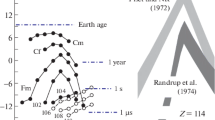Abstract
The story of the first synthetic elements is one interlinked with the development of nuclear science and atomic weapons. As such, its impact is often overlooked or underestimated, particularly in how the hunt for elements affected research priorities and contributed to the prestige of the discoverers, many of whom would go on to hold influential positions throughout the cold war. This review focuses on the first attempts to synthesize transuranic elements in the 1930s until the discovery of einsteinium and fermium in 1952. It charts the discovery of the elements, gives context to the character of the discoverers, describes some of their more colorful adventures and provides wider context in terms of the political and scientific changes occurring at the start of the atomic age, which set the scene for the so-called “transfermium wars” and the hunt for the superheavy elements.
Access this chapter
Tax calculation will be finalised at checkout
Purchases are for personal use only
Similar content being viewed by others
Notes
- 1.
Throughout this chapter, I will refer to the discovery of synthetic elements; while some philosophers of science have questioned whether synthesis counts as “discovery” in the traditional sense, that debate is outside the purview of this discussion.
- 2.
Segrè was Jewish, and had been en route to California in 1938 when anti-Semitic laws were passed banning Jewish academics from holding professorships in Italy. Rather than return home, he decided to continue his career in the United States.
- 3.
While McMillan and Abelson are credited with the discovery of neptunium, it is worth noting that in Japan Yoshio Nishina, using a cyclotron based on Lawrence’s design, almost certainly produced neptunium too. He was, however, unable to prove his discovery.
- 4.
Seaborg’s personal influence, which would only grow throughout his lifetime, cannot be understated. In 1998, members of the American Chemical Society voted Seaborg the third greatest chemist of the past 75 years, behind organic chemistry doyen Robert Burns Woodward and two-time Nobel laureate Linus Pauling [8].
- 5.
The discovery, analyzed in Chicago, was based on a bombardment of 239Pu by helium ions at Berkeley.
- 6.
Richard Williams would become a career diplomat and served as the first US ambassador to Mongolia and later Consul General in Hong Kong.
- 7.
Strictly speaking, priority was contested over californium by the Soviet physicists Znoyko and Semishin on the basis they had predicted the elements’ properties two years prior to its synthesis. However, this claim was considered spurious and ignored.
- 8.
Seaborg died in 1999. He remained the only person to have an element named after them while still alive until 2016, when Flerov’s successor Yuri Oganessian was recognized with element 118, oganesson. Lawrence (103), Meitner (109) and Flerov (114) would also have elements named after them.
References
Wells HG (1913) The world set free. Macmillan, London
Ellis CD, Henderson WJ (1934) Artificial radioactivity. Proc Roy Soc Lond A 146:206–216. https://doi.org/10.1098/rspa.1934.0149
Chadwick J (1932) Possible existence of a. Nature 129:312. https://doi.org/10.1038/129312a0
Fermi E (1934) Possible production of elements of higher than 92. Nature 113:898–899. https://doi.org/10.1038/133898a0
Noddack I (1934) Das periodische System der Elemente und seine Lücken. Angew Chem 47:301–305. https://doi.org/10.1002/ange.19340472002
Fermi L (1954) Atoms in the family: My life with Enrico Fermi. University of Chicago Press, Chicago
Chapman K (2019) The first synthetic element. Nature 565:570–571. https://doi.org/10.1038/d41586-019-00236-4
Chapman K (2019) Superheavy. Bloomsbury Sigma, London
The Nobel Prize in Physics 1938. https://www.nobelprize.org/prizes/physics/1938/summary/. Accessed 30 May 2020
Meitner L, Frisch O (1939) Disintegration of uranium by: a new type of nuclear reaction. Nature 143:239–240. https://doi.org/10.1038/143239a0
Seaborg GT, Seaborg E (2001) Adventures in the atomic age. New York, Farrar, Straus and Giroux
Segrè E (1939) An unsuccessful search for. Phys Rev 55:1104–105. https://doi.org/10.1103/physrev.55.1104
McMillan E, Abelson P (1940) Radioactive element 93. Phys Rev 57:1185–1186. https://doi.org/10.1103/physrev.57.1185.2
Segrè E, Seaborg GT (1938) Nuclear isomerism in element 43. Phys Rev 54:772. https://doi.org/10.1103/physrev.54.772.2
Hoffman DC, Ghiorso A, Seaborg GT (2000) The transuranium people: The inside story. Imperial College Press, London
Seaborg GT, James RA, Morgan LO (1949) Vol 14 B The transuranium elements: research papers, National nuclear energy series vol 14B, Paper 22.1. McGraw-Hill Book Co, New York
Mars Curiosity Rover: APXS. https://mars.nasa.gov/msl/spacecraft/instruments/apxs/. Accessed 30 May 2020
Cochran T, Norris R, Bukharin O (1995) Making the Russian bomb: From Stalin to Yeltsin. Westview Press, Boulder CO
Thompson SG, Seaborg GT, Ghiorso A et al (1950) The new element (98). Phys Rev 80:790–796. https://doi.org/10.1103/physrev.80.790
Goeppert-Mayer M (1949) On closed shells in nuclei. II. Phys Rev 75:1969–1970. https://doi.org/10.1103/physrev.75.1969
Wheeler JA (1955) Nuclear fission and nuclear stability. In: W (ed). Niels Bohr and the development of physics, Pergamon Press, London
The Nobel Prize in Chemistry 1951. https://www.nobelprize.org/prizes/chemistry/1951/summary/. Accessed 30 May 2020
US Air Force (1963) History of Air Force atomic cloud sampling. US Air Force, Washington, DC
Ghiorso A, Thompson SG, Higgins GT et al (1955) The new elements and 99 and 100. US Atomic Energy Commission, Berkeley
Rhodes R (1987) The making of the atomic bomb. Simon & Schuster, London
Barber RC, Greenwood NN, Hrynkiewicz AZ et al (1993) Discovery of the elements. Part II: Introduction to discovery profiles. Part III: Discovery profiles of the transfermium elements. Pure Appl Chem 63:1757–1814. https://doi.org/10.1351/pac199365081757
Author information
Authors and Affiliations
Editor information
Editors and Affiliations
Rights and permissions
Copyright information
© 2021 The Author(s), under exclusive license to Springer Nature Switzerland AG
About this chapter
Cite this chapter
Chapman, K. (2021). Element Discovery and the Birth of the Atomic Age. In: Giunta, C.J., Mainz, V.V., Girolami, G.S. (eds) 150 Years of the Periodic Table. Perspectives on the History of Chemistry. Springer, Cham. https://doi.org/10.1007/978-3-030-67910-1_13
Download citation
DOI: https://doi.org/10.1007/978-3-030-67910-1_13
Published:
Publisher Name: Springer, Cham
Print ISBN: 978-3-030-67909-5
Online ISBN: 978-3-030-67910-1
eBook Packages: Chemistry and Materials ScienceChemistry and Material Science (R0)




